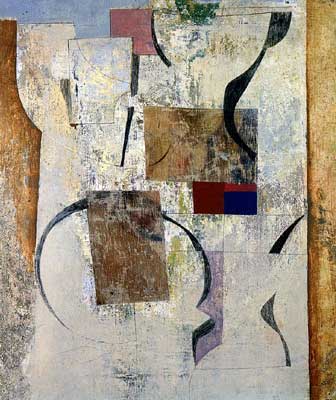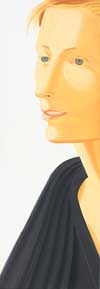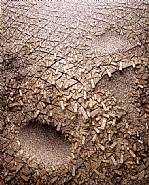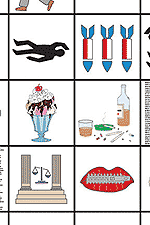
From Poetry to Pseudo-Politics
Ben Nicholson at Jacobson Howard; Alex Katz at Pace Wildenstein; Kwang-Young Chun at Kim Foster Gallery; Nancy Chunn at Ronald Feldman Fine Art
by Maureen Mullarkey
Ben Nicholson is a great classicist who brought to British modernism a clarity and reticence that transcends nationality and style.
The continuing relevance of his painting resides in its abiding loveliness. Suggestions of national temperament or Mr. Nicholson’s role, however crucial, in the development of British abstraction in the 1930s are secondary. The pleasure of this exhibition at Jacobson Howard Gallery is available without reference to historic significance. As the tendentious climate of the early European avant-garde recedes, the more clearly we distinguish Nicholson’s pictorial genius and the eloquence of his hand.
 |
| Italian Wall |
Born to a family of painters and quickened by the School of Paris, the artist understood himself—as did Braque—to be a workman. Consummate craftsmanship informs every centimeter of these paintings, balancing euclidian austerity with enlivened surfaces and sensitive color play. He challenges the capacities of a flat surface with an architectonic approach that merges painting and carving. Color itself is handled as a form of relief. Areas of solid pigment advance from sections scraped back with renunciatory scruple, sometimes to the raw linen. In “Italian Wall” (1955), the linen is abraded clear through, leaving breaks in the weave.
His seminal “White Relief” (1936) balances a solitary square and circle on a single panel. Wood is cut away from the square so that it appears embossed on the same plane into which the circle was incised. Mr. Nicholson’s whites alone are remarkable, ever shifting in weight and warmth.
This is the first exhibition of his work in New York for more than a decade and must not be missed. It is beautiful painting, serious and integral.




 |
| Tilda |
Alex Katz writes movingly about painting and his own relation to it. That leads us to expect more than meets the eye in his trademark figures. But it is not there. These brobdignagian absentees, vacant and affectless, declare their abstention from everything but size. Mainly portraits of trendy models and artists, the PaceWildenstein exhibition is a study of celebrity/fashion admiring itself. It illustrates Jacques Barzun’s observation that art-and-culture is one word. It means prestige and money.
Only “Mariko” (2004) emerges persuasively from a spent recipe. Others are lazy caricatures that do not earn their yardage. Frédéric Bartholdi said of his Liberty that the colossal “should touch the spectator’s feelings, not by reason of its sheer size, but because the size is right for the idea that prompted it.” The larger Katz’ work grows, the more meager the motivation seems.
Cheerily credited (sans apology to Shephard) with having reconciled the figure with the canons of abstraction, Katz is not all that interested in the figure. He toys with it, like a bored colonel in some Crown colony teasing the natives. His real interest is scale. That is the lesson of his meticulous collages and cut-outs. In these, as in his smaller paintings, Katz explored scale as a matter of internal relationships, not of dimension. Accordingly, his small works have a poise and authenticity that the larger ones lack. Monumentality derives from qualities of mind for which bulk is no substitute.
Katz’s debt to the billboard advertising is old news. But his specific debt to Otis Shephard, art director of Wrigley’s Gum in the 50s, deserves more attention than it gets. Shephard originated—without benefit of briefing by Harold Rosenberg on the creed of Flatness—those totally level cropped heads that became Katz’s signature.
By now, he is producing Alex Katzes, a brand like any other. But brands, like styles, come and go: Packard, De Soto, Old Dutch Cleanser. None are inevitable.




Kwang-Young Chun’s minimalist sympathies transform Korean folk practice—devotion to paper talismans—into compelling abstractions. In an ongoing series called “Aggregations,” now at Kim Foster Gallery, the artist conjures rhythmic compositions out of hundreds of amulet-like packets, bound triangles of inscribed mulberry paper wrapped around an unseen core.
 |
| Aggregations |
He arranges these in clusters that undulate across the support in transverse waves, swelling and cresting like a migration of electrons. If the artist’s structures are simple, his components are a multitude of intricate, delicately crafted details. The subtle dance of particles is sculptural; Its tactility providing counterpoint to shifts of light delicately modulated by tonal variations in the paper.
Recent work exchanges some of the poetry of previous designs for heightened spatial definition. Current pieces suggest a terrain pocked with depressions and steep hollows. I miss the seamlessness of previous compositions; but these latest remain elegant and seductive. While impetus is an inspired memory from his cultural past, the artist’s achievement is thoroughly contemporary. Western art’s welcome to elements forged outside itself provides formal structure for Mr. Chun’s expression of his own national identity.




Ronald Feldman Fine Art is the impresario of politicized sloganeering; hence, this post-convention panty raid on geopolitics: the cartoons of Nancy Chunn, a pulpiteer still chafing over the 2000 election and original sin.
 |
| 9/11 (detail) |
One hesitates to gloss “9/11” (2002-4). Bumper sticker politics reduce handily to smart-alecky logos. Ms Chunn paints one per box on large gridded canvases. A schematic pair of red lips closed by a zipper symbolizes—any guesses?— suppression of free speech. Who wields the muzzle? Answer lies not in her equivocal cliché but in the context of the venue itself.
Ms. Chunn’s scales of justice are pointedly lopsided. Against whom? Ignore specifics; posture is everything. Down with oppression! And just say no to chocolate sundaes, cigarettes and street crime, too. Her images are rhetorical devices designed to gull us into believing that the art is significant because of the seriousness of its real life referent.
Predictably, there is no graphic suggesting a conquering Islam. But there are red-white-and-blue bombs, prerequisites for ideological titillation. All you need is a single title—“Chicken Little and the Culture of Fear” (2004)—to gauge the character of Ms. Chunn’s grasp of events. Orwell’s dictum that there is always room for one more custard pie applies here in spades. Plausible engagement with social realities is obviated by coy puerilities that deflect attention from the complexities of actual circumstances and the weight of a moral vision.




“Ben Nicholson” at Jacobson Howard Gallery (19 East 76th Street, 212-570-2362).
“Alex Katz: Twelve Paintings” at PaceWildenstein (534 West 35th Street, 212-929-7000).
“Kwang-Young Chun: Aggregations 2004,” at Kim Foster Gallery (529 West 20 Street, 212-229-0044).
“Nancy Chunn: Paintings 1982-2004” at Ronald Feldman Fine Arts (31 Mercer Street, 212-226-3232).
A version of this essay first appeared in The New York Sun, September 16, 2004.
Copyright 2004 Maureen Mullarkey







